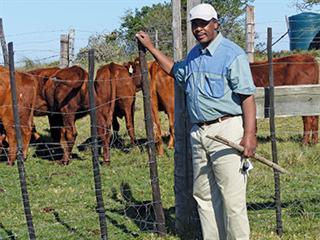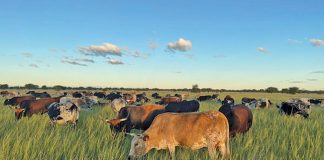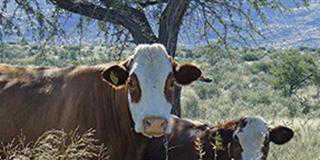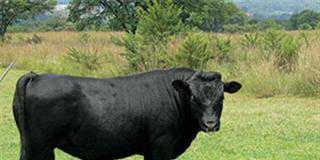
“I believe that if you want improvement in your herd, you must buy the best bull and ram,” says Desmond Siteti (58) near his home in Pikoli along the Great Fish River. “I don’t mind paying for quality, because in the end I know I’ll produce quality livestock.’’ Since leaving the Eastern Cape for the mines in 1979, Desmond has invested substantially in acquiring Boer Goat rams since the mid-1980s and Bonsmara bulls since 2002 to improve the quality of offspring within the Siteti family’s communally based goats and cattle.
He sums it up simply. “I’m not looking here,” he says, pointing at the dust a few metres ahead. “Instead, I’m looking there.” He extends his arm to the horizon, beyond the Fish River. For 15 years, Desmond’s brother Melford managed the day-to-day tasks of the farming operation while Desmond worked on the mines. Then in 2004 Melford died, and Desmond was forced to confront the logistics of managing the enterprise on his own – and from Gauteng.
He made a brave decision: to keep both the farm and his job in the processing division of the Gold One Group, an arrangement that necessitates constant travel between Gauteng and the Eastern Cape.“I didn’t want to lose the land and the livestock,” he says. Nine years later, Desmond is still in no hurry to resign – at least not until his livestock enterprise is flourishing.
Beginnings
For Desmond, livestock farming is all about genetic improvement and correct management to boost production. It’s therefore unsurprising that while in Gauteng he has completed as many livestock management courses as possible, including a highly-rated Boer Goat management course in Potchefstroom in 2008. But it was while growing up on a commercial farm near Grahamstown in the Eastern Cape – where his father Thompson attended to the goats – that Desmond received his initial grounding in livestock management.

Boer Goat- and Savannah-type kids on Tower Hill.
“After school, we used to help collect the goats and kids and were shown how to look after them,” he recalls. “I just grabbed on the knowledge and have built on it since.” However, he knew that if he wanted to farm he would have to strike out on his own, as the Siteti family was allowed to run only five or so cows on the farm where Thompson was employed. After Desmond had made the pilgrimage to the mines, the family relocated to the communal area of Pikoli across the Fish River. Here they began to increase their herd of cattle and established a small flock of indigenous goats.
The value of the white goat
Although Desmond appreciates the traits of his family’s indigenous goats, he believes that buying his first Boer Goat rams in 1986 was a sound idea, as this improved the conformation of the kapaters. While indigenous goats are exceptionally hardy (“most farmers don’t dip or dose them,” says Desmond), they don’t have a great deal of meat.
Furthermore, producing predominantly white Boer Goats (from a current flock of 115 breeding females) gives Desmond a distinct advantage in the traditional trade, where white goats are needed to ‘banish’ bad luck. Peak times in this trade are during the June and December school holidays when Xhosa initiates across the Eastern Cape retire to the bush to complete the rite leading to manhood, as each youth is required to slaughter two goats.
According to Desmond, a goat even better suited to this trade is the 100% white Savannah. He bought his first goats of this breed – 40 ewes and a ram – from John Dell near Grahamstown in 2009, and today farms a flock of Savannahs on the commercial farm Tower Hill near Grahamstown. He has leased the farm since March last year from the state as part of the Proactive Land Acquisition Strategy programme.
Dipping, feed, and marketing
Desmond’s predominantly Boer Goat-type flock in Pikoli receive no supplementation in the sweetveld along the Fish River. They are dipped every week in summer and every second week in winter to control ticks in this virulent Heartwater veld. Desmond has also found it necessary to deworm the goats every three months on average.The Savannahs on
the predominantly sourveld of Tower Hill are managed in exactly the same way, except that they are allowed the protein lick put out for the cattle in winter.
Boer Goat and Savannah rams are run with the ewes all year round. The ewes of the two breeds are kept in separate flocks and kid mostly from May to September at an annual rate of about 120%. Kapaters are marketed from six to 18 months of age. About 20 are sold each year at a commercial auction in Grahamstown. The young ewes, apart from a small group of selected replacement animals, are sold each year as breeding stock to communal and emerging farmers.
Choosing Bonsmaras
In 2002, Desmond introduced a good Bonsmara bull to the family’s herd of crossbred cattle, and was considerably impressed by the quality of its calves. Since then, he has always bought Bonsmara bulls. Eight years later, he added 12 young Bonsmara heifers – purchased from Darryl Fetting near Fort Beaufort – to his herd at Pikoli. And in 2012, he
bought a Bonsmara bull for R34 000 at the Frontier Bonsmara Sale in Grahamstown.

A group of 10-month-old weaners on Tower Hill Farm. They were bred from the Siteti family’s herd of predominantly old cows using a Bonsmara bull.
“The Bonsmara doesn’t take nonsense,” he says. “It can adapt to any situation without losing condition.” But managing a herd of cattle in the communal areas of the Ciskei proved to be a nightmare. Without fencing, Desmond’s cattle would come into regular contact with other communal herds that would introduce disease, rogue bulls and the associated poor calves.
“With communal land there’s no control,” he says. “For example, I dip, but other people don’t. You can’t farm commercially in the communal areas. You can have all that passion but after a while you lose hope.” Tower Hill farm finally became available to Desmond in 2012 and it was with great relief that he was able to move all his cattle there. With good fencing, Desmond has been able to separate his bulls for the first time and define breeding seasons. He was so inspired by his new circumstances that he bought more female Bonsmaras, including eight cows in calf, from Darryl.
Breeding
Today, Desmond runs 40 Bonsmara-type females with 25 older cows of various breeds belonging to the family. All cattle are dipped weekly in summer and every two weeks in winter. They receive a phosphate lick in summer and a protein lick in winter, while cows and heifers are mated to calve from September to November. The herd (including the family’s 25 older cows) achieved a calving rate of 70% in 2012. Calves are weaned at eight months and marketed at nine to 10 months of age.
A selection of oxen is grown out to two to three years and sold on the traditional market, while some heifers are sold to communal and emerging farmers.
Contact Desmond Siteti at 083 418 5558.













